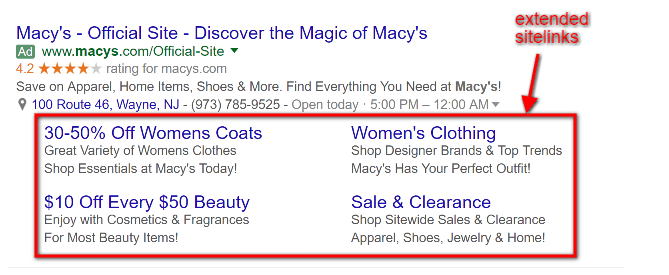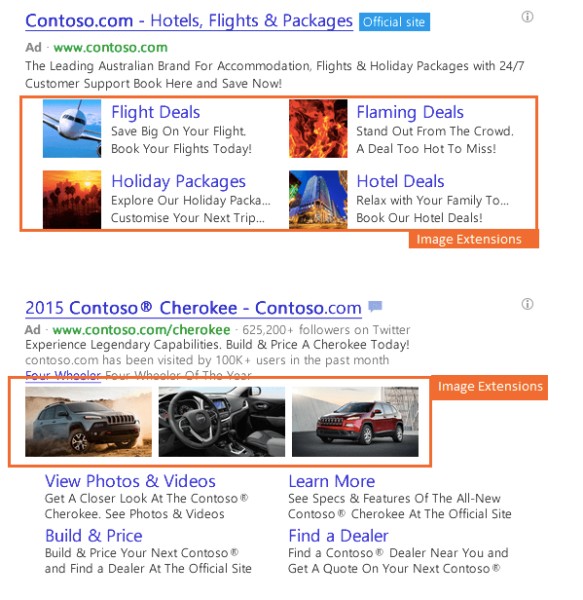Ad extensions for the entire decision journey
How can you use ad extensions to move potential customers further down the sales funnel? Columnist Mona Elesseily shares some tactical advice.

Not only do ad extensions work to encourage immediate sales, but they can also be used to move consumers along the decision journey/buy cycle. In our work, we’ve effectively used ad extensions in many stages of the buy cycle, for instance:
- When searchers research products online (research stage)
- When searchers home in on a specific product
- When searchers want to see products in person/offline
- And, of course, when they are ready to buy something immediately (online/offline)
In this article, I’ll cover appropriate ad extensions for the decision journey stages I mentioned above. I’ll also provide pointers and warn of potential ad extension pitfalls.
1. When searchers research products online (research stage)
At this stage, our goal is to convince shoppers that they want to buy a particular product/service. The most effective extensions for the research stage are:
- extended sitelinks
- review extensions
- video extensions (Bing only)
Below, I’ll talk specifically about extended sitelinks and video extensions.
Extended sitelinks
Sitelink extensions give you the ability to add additional links to your ads. When we talk about “extended sitelinks,” this means that you have filled out the optional description line for each sitelink.
Extended sitelinks create more room to grab interest and encourage people to engage with your brand/product/service. It’s also a good place to focus on information I know will resonate with searchers.
Here are a couple of sitelink pointers:
- In many cases, extended sitelinks perform better than sitelinks with no link descriptions. In our experience, they have higher click-through rates (CTRs) and more conversions. We’ve seen a 3x increase in conversions and a 25 percent decrease in CPA from using extended sitelinks.
- Using ETAs (expanded text ads) with extended sitelinks is an awesome one-two punch.
- Extended sitelinks combined with one or two additional ad extensions performed well for us in our testing.
Video extensions (Bing Ads only)
Many people watch videos before buying a product or service. For example, many folks who do DIY home repairs gauge the difficulty of a job by watching a video or two. If the job doesn’t seem difficult, many searchers will then go on to buy the products needed to make repairs. So, easy how-to videos are a great way to encourage sales.
Here are some effective video tips:
- Aim for short videos. For a how-to video, three to five minutes is ideal.
- Aim for “quick and easy” solutions. For example, no one wants to watch a 45-step tutorial on how to fix a leaky faucet. They won’t be compelled to watch or to attempt to fix their faucet.
2. When searchers home in on a specific product
Once searchers are interested in your brand and/or company, we like to use callout extensions or image extensions to provide additional information.
Below is an example from Nike. In the ad, they provide more info and “call out” the following info: “Extended 60 Day Returns · All Orders Ship Free · Now Delivering to Canada.”
We also like to use image extensions (Bing only). Images really grab users’ attention, and a big reason we’re seeing more images in SERPs in general is that they are so visually engaging. Below are a couple of ways image extensions can appear in Bing:
If your product feed isn’t up to snuff, image ads are certainly an alternative way to get eyeballs.
3. When searches want to see products in person/offline
Ad extensions are also effective at directing people to offline locations. Naturally, location extensions and call extensions are a good way to encourage people online to transact offline.
Here are some pointers:
- With call extensions, be sure to turn them off (schedule them off) when your call center is closed, or you’ll do more harm than good.
- A good strategy is to use different numbers for different customer needs. For example, you can dedicate one number for calls to your sales department and another for calls to your service/technical support team.
Seller ratings are also good at encouraging offline sales (and can be effectively used in the research phase as well). It’s worth noting that the thresholds for Google Trusted Store seller ratings have recently changed.
Now, in order for star ratings to appear, you need at least 150 unique seller reviews from the past 12 months. The previous threshold was 30 reviews over a 12-month period.
4. When they are ready to buy something immediately (online/offline)
There are new extension products that help people buy directly in PPC ads. For example, Bing has action link extensions,which allow advertisers to include a direct call to action, like a “buy now” or “reserve now” button directly in an ad. Google has been testing variations of this type of ad unit as well.
There are also app extensions, which naturally help people download apps. Of course, the trick with any app is not the initial download but finding ways to keep people engaged and using your app.
Final thoughts
Ad extensions were created for a reason: to make your ads more engaging and useful to searchers. When used strategically and thoughtfully, ad extensions can help move prospects closer toward the final sale at all stages of the buyer journey.
Contributing authors are invited to create content for Search Engine Land and are chosen for their expertise and contribution to the search community. Our contributors work under the oversight of the editorial staff and contributions are checked for quality and relevance to our readers. The opinions they express are their own.
Related stories
New on Search Engine Land



